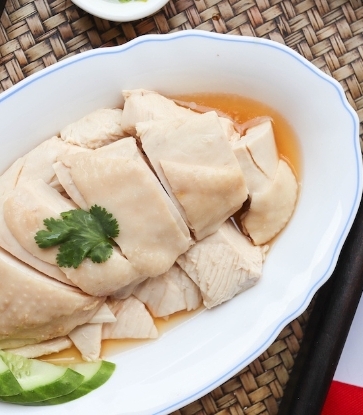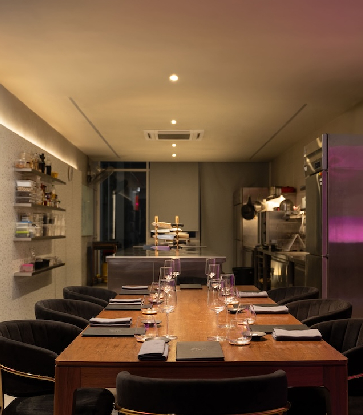Lamiat can be interpreted in many different ways. For Chef Thaninthorn Chantrawan, or Chef Noom, of Chim by Siam Wisdom, Lamiat is the authenticity and passion for the little details that make up the big picture. The authentic taste of ancient and traditional Thai cuisine served by the Michelin-starred chef encapsulates the legacy of Lamiat, a philosophy that can be traced back throughout Thai history. Brewing the same philosophy into each of their bottles, Chang’s Lamiat appreciation for history and craftsmanship makes it a perfect companion to each and every dish at Chim by Siam Wisdom.
Those well-versed in the Thai culinary scene would be familiar with Chef Noom and his restaurant, Chim by Siam Wisdom (1 Michelin Star). To the veteran chef, Lamiat lies in the preservation of one’s heritage. “While we do incorporate modern techniques in our cooking (e.g. sous vide the meat) if necessary, I try to keep everything as authentic and genuine as possible.” Striving to serve the Lamiat taste of authentic Thai cuisine, Chef Noom’s creations are classic dishes that include rare boran (ancient) recipes—some of which date back to almost two centuries in history. “We are currently serving Yum Goong Sa-er, which has existed for about 100-150 years, while the Tom Yum Pla Chon Boran originated from about 200 years ago during the reign of King Rama II.”
When determining what makes a dish Lamiat, ingredients play a crucial role. Known for their authentic and delicate taste, the menus here are created seasonally to provide patrons with the taste of the finest produce whenever they visit. It is not just the ingredient itself, either. Lamiat is carried in the process of ingredient selection right to the way they are incorporated into each of the dishes. “The first thing I always consider is the ingredients that will be used. Whenever we decide to cook something, we never jump to how the dish will be presented or who will be cooking it. The first and foremost focus is on the main ingredients that will be used. After that, we will then look at how we are going to assemble the dish. Say if we’re cooking a curry, we’d look at which kind of fish or meat will be used and the type of curry we will be cooking e.g. southern or northern curry.”

Lamiat is not only demonstrated through one’s cooking process. It is also reflected in the determination to seek out and source the best ingredients. An advocate for fresh wild-caught ingredients, Chef Noom would travel across Thailand himself to search for the best raw materials, even if it means driving out of Bangkok every 2-3 days to other provinces. "I always love to go to Nakhon Pathom, Mae Klong, Chonburi and Uthai Thani. Uthai Thani is a good place to look for wild forages, while I love going to Chonburi for its fresh seafood.” It is such dedication that demonstrates the Lamiat in Chef Noom’s culinary practice. “Sometimes I would take these trips without knowing what I wanted to get, and then there are times when I would head to a province with the aim to get something but ended up not getting it because it wasn’t available.”
Like a well-brewed beverage, Lamiat is also the wisdom garnered through years of knowledge and experience. A native of Nakhon Pathom, Chef Noom enthusiastically explains that the province yields some of the best shrimp paste and lime. “Unlike other provinces famous for their shrimp paste or chilli, Nakhon Pathom is not known for these ingredients. However, because the province is actually situated along the river, you can get very fresh wild-caught snake-head fish and shrimp paste. The lime and chilli from Nakhon Pathom or Sampran are also brilliant as they are very aromatic and produce a lot of juice as well as good acidity.”

There is no doubt that Lamiat and ancient Thai cuisine are two sides of one coin. Aside from the ingredients itself, Thai cuisine is defined by the fine details. The precise requirements for the preparation and the sourcing of ingredients for each Thai boran dish perfectly captures the essence of Lamiat. “Every single aspect in ancient Thai recipes is very meticulous, from the way you peel the herbs to the way you use your salt (you have to select a female or male salt according to the dish). The source of the ingredients also matters as well. You have to use chilli from a particular place, and the paste has to be made by hand with pestle and mortar. Then you also have to be specific about the way you make the broth or the fish that you use.” This, too, extends beyond the cooking process. Lamiat also lies in the diligence and passion to search for techniques used in ancient recipes that might have been forgotten through time. “You have to dig down and discover them yourself. It’s all about doing your research and asking the right person. There are also some techniques that are not used today, which means more experimenting and practising for a few times before you eventually get it right.”

A firm believer in the importance of precision and details, Chef Noom explains why he has chosen to create and serve authentic as opposed to fusion Thai. “When you think about Lamiat, it is all about precision. With fusion food, however, some of the processes or details may be altered or skipped under the pretext that it is ‘a new cooking technique’. Such reduction and simplification mean that Lamiat is lost during the process. Lamiat is about showing your diners how the ingredients were selected, how the dish has been prepared and the way it is presented. With fusion, however, all of that is lost. You might be cooking green curry, Tom Yum Plachon or Phanaeng with salmon or cheese to thicken it up, and that takes away the essence of the dish. With authentic Thai food, it’s different. It’s all about how the taste is captured, how it’s been cooked right to the presentation, including the size of the portion. All of these combine to make a dish Lamiat. It means that you can’t make a mistake because every single element counts.”
The Thai philosophy of Lamiat is not something that one follows, but rather something which one embodies through their actions and beliefs. In respect for Chef Noom’s impeccable creations at Chim by Siam Wisdom, the experience of Lamiat would not be complete without a perfect beverage to complement the meal. Sharing the same philosophy of respect and craftsmanship, the harmonious and refreshing taste of Chang Lamiat makes the two a match made in heaven.
This content was brought to you by Chang, Official Partner of the MICHELIN Guide 2018.
www.changbeer.com
www.facebook.com/changbeer/
Here's what our inspectors said about Chim By Siam Wisdom (1 Michelin star)
The kitchen revisits traditional Thai recipes to create dishes that strike a balance between the old and the new and between Thai and foreign influences. Order from the à la carte and share among friends or choose a fixed price menu to sample a dazzling variety of flavours. Ancient tom yum with river fish and freshly made curries are among the unmissable dishes. The restaurant was renovated in 2017.
















